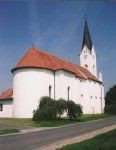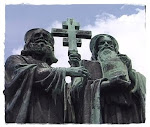Nadam se da će nam Daniel u nekom budućem članku opisati i religijsku situaciju u Češkoj s posebnim osvrtom na katoličku tradiciju, a sad vam preporučujem da pročitate o ovoj manje poznatoj grani hrvatskog iseljeništva.
***
Croatians in Moravia
I was kindly asked by Toma to write an article on the Moravian Croatians. Being one of the descendants of those proud people, I am glad to do it. I beg you pardon to do so in English. I can understand and read in Croatian but to use the language actively is quite hard for me as I was never studying it at school.
First settlement
Until these days there exists a small Croatian minority in the South Moravia. First Croatians sought there a safe exile before the cruel Turkish attacks which took place in their country. They were leaving their homeland during the 16th and 17th century, i.e at the time when the Turkish expansion was at its peak. The community itself became the oldest, northernmost, and farthest Croatian diaspora in Europe.The emigration has started soon after Suleyman the Magnificent with his army had won the battle of Mohacs in 1526. The advance of the Ottomans (Turks) into central Europe drove countless Croatians to seek protection of the Hapsburg crown. It is believed that the colonization of the Croatians began from the Croatian regions south of the Kupa river and Petrova Gora, the regions known as Banija or Banska Krajina as was summarized by the Czech academician Adolf Turek.
These emigrants settled in the stretch between Austrian and Hungarian lands from the Drava and Mura rivers in South to the Danube river in the South Slovakia and at the confluence of the rivers Morava and Dyje in Moravia. Most part of this Croatian body is today found in Burgenland in Austria and is known under the name Gradišćanski Hrvati (or the Burgenland Croatians). Besides Moravia, there are Croatian villages in the South Slovakia, too. Language, culture, and faith were three fundamental guides of the Croatian national corpus which influenced the survival and existence of the Croatians in this region.
The oldest notice of Croatians in Moravia dates back to 1539. This was the year when Croatian villages of Poštorná, Hlohovec, and Charvátská Nová Ves were settled. These Croatians probably came here from the area of the Una and Kupa rivers. Later on Frélichov (todays Jevišovka), Dobré Pole, and Nový Přerov villages were occupied. At the end of the 16th century Croatians were also present around the towns of Hodonín and Břeclav. Another wave of emigrants came to Moravia during the 17th century. This time they moved to areas where their compatriots has already settled.
Original Croatian Settlements in Moravia
All the Croatian enclaves broadened after the Thirty years´ war (1618-1648) and Croatians also occupied villages left empty after the war. This was the era of the Hapsburg re-catholization of the Czechlands and as Croatians were faithful Catholics, they were welcomed immigrants and even had some special privileges – e.g. until the end of the 17th century they had the right to have their own priests who knew Croatian language and were usually coming from Croatia itself.
The area of the South Moravia was inhabited by three nations – Czechs, Croatians, and Germans. Croatians sometimes called themselves to be a “people of three languages“ as they spoke Croatian but also Czech and German. A part of Croatian community was naturally assimilated either with Czechs or Germans after some time, but most of it lasted until the end of the Second World War.
“First republic“ (1918-1938)
In 1918, after almost 400 years since the first settlers had been coming, there was still a Croatian population of 1700 people in the South Moravia. At the time of the so-called “First republic“ (1918-1938) the situation was paradoxically worse than at the time of the Austro-Hungarian Empire. The Croatians were exposed to the strong pressure of “Czechization“ and were viewed as the Slavic element which should incorporate to the Czech (and Slovak) nation. The Czech leaders of Czechoslovakia were mostly anti-Catholic and Catholicism was understood as the religion of the hated Hapsburgs. Some of the leaders were also free masons or were influenced by them.
And what was the religious life of the Croatians like at that time? Hard. There were no direct ties of the Church in Croatia and the Croatians in Moravia. Holy mass was held in Latin mixed with Croatian. There are however some personalities never forgotten in the consciousness of the Croatian community. One of them is pastor Vjekoslav Malec from Dobro Pole village. He faithfully worked to keep Croatian from being squeezed out of religious rites. Though he was Czech by his nationality, he took a great unselfish care of the Croatians there. He was teaching Croatian children Croatian language, wrote a book of 2000 pages on Croatians, published Croatian prayers etc. Thus he deserved the title “the little apostle of the Moravian Croats“ and he will never be erased from the memory of the Moravian Croatians.
Oče naš (kako se izgovara u Gutfjeldu)
Oče naš, kjesi na nebesih,
svjeti se ime tvoje,
preidi nam kraljevstvo tvoje,
budi volja tvoja,
kako ná nebi tako na zemi,
kruh naš svakidanji daj nam ga Bóg danas,
odpusti nam duge naše,
kot i mi odpušćamo dužnikom našim,
nevedi nas napas,
baviti nas od šega zla.
Amen.
(You can see there are some bohemisms (=čehizmi) present in it.)
After the Munich conference
After the Munich conference in 1938 the border area where Croatians lived was devolved to the National Socialist Germany. In view of the fact of establishing of the NDH – a faithful German ally – Croatians received some privileges and minority rights. On the other hand, some of them had to join the Wehrmacht and were sent to the Eastern front. All of this was fatal for the whole Croatian community after the Soviet victory in 1945 and especially after the Soviet-Yugoslav break after 1948. Croatians were accused of being the Nazi collaborators. And because they strongly opposed “Czechization“ and for more in the first elections after the Second World War in 1946 majority of Croatians voted for the only legal right wing party – Czechoslovak people´s party (the Catholic oriented party) – their fate was sealed..
The Communist repression
After the Communist putsch in 1948 the Croatian community was labeled „unreliable and hostile“ and it was dispersed over 100 villages of the whole Bohemia and Moravia. They were also prohibited from all community activities at all. Until that time the unbroken consciousness of the Moravian Croatians of their national origins as well as their deep-rooted religious believes particularly illuminated all the researchers as states Jasmina Kovacevic-Cavlovic in her article „Moravian Croats“.
Testimony to the unbreakable national orientation is an inscription on a restored monument from 1928:
| Hrvatsko selo, Hrvatski ljudi, Hrvatski jazik, Hrvat ljubi! Hrvat si kodno more reć, da je nikdo ništa već, nek si ti, brat tvoj, od lieta selijena bruoj. |
A Croatian loves Croatian village, Croatian people and Croatian language! You are a Croat who can be said that no one is greater, be it you or your brother, who count the years of migration. |
In original villages in the South Moravia only 19 ethnic Croatians stayed in 1961. The apology for this persecution came only in 1999 when the government plenipotentiary for minorities in his speech on the occasion of Croatian meeting in Jevišovka officially apologized for it.
Croatians today
In the 2001 census of the Czech republic, there were 1585 persons who claimed for the Croatian nationality. Since the 1990´s the Association of Citizens of Croatian Nationality (Sdružení občanů chorvatské národnosti) is functioning. The main aim is to maintain the old Croatian habits, customs, traditions and also language which is an archaic form of the Chakavian dialect.
From 1991 the annual meetings are held in Jevišovka in the beginning of September where Moravian Croatians and also compatriots from Austria and Slovakia join together. “The Croatian Cultural Day“, as is the official name of it, always opens with the Holy mass in Croatian in the St. Kunhuta church in Jevišovka and continues with presentation of old Croatian customs and the meeting around a monument dedicated to Croatians (Moravian immigrants) which was established there in 1884.
The Croatian Cultural Day 2008
Thanks to cooperation of Nový Přerov and its Austrian counterpart of Neu Prerau, the St. Michael´s church, originally built up 400 years ago by the Croatian immigrants, was restored in Nový Přerov in 2000. Association also managed to open the museum on the history and life of Croatians in Jevišovka.
St. Michael´s Church in Nový Přerov
The End?
Some people say that the Croatian community in the Czech republic is already dead – dispersed, assimilated, and lost forever. Some say it somehow exists as a kind of cultural curiosity. It all may be right. In my opinion however the Croatians here are not dead until there is the last of us who considers himself a Croatian and keeps the Catholic faith of his forefathers.
Bog i Hrvati!
Daniel
More information in Croatian:
Dragutin Pavličević: Moravski Hrvati – povijest – život – kultura", Zagreb 1994.









Nema komentara:
Objavi komentar
Upute za komentiranje
Kako bi se razlikovali sugovornici, obavezno koristite neko ime ili nadimak koji možete dodati i na kraju komentara. Potpuno anonimni komentari najčešće se brišu.
Nijedan komentar objavljen na ovom blogu ne podrazumijeva ni u kojem stupnju prihvaćanje od autorâ ovog bloga mišljenja koja su u komentaru izražena.